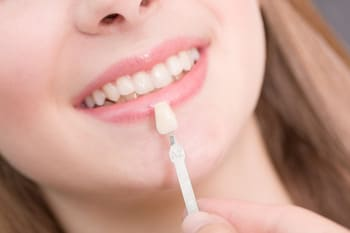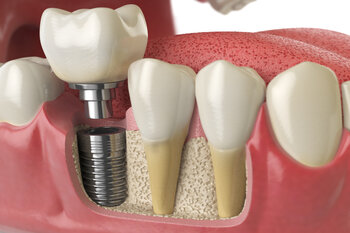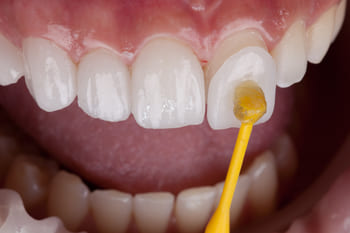Dental health is more than just a reflection of our oral hygiene; it’s intimately tied to our self-esteem and how we present ourselves daily. While sparkling teeth might be everyone’s dream, not all of us are blessed with a perfect set. Enter the world of dental restorations, where solutions like veneers and crowns have become popular routes to achieving that coveted smile. While both serve as methods to enhance teeth’ aesthetic and functional aspects, they are quite distinct in their applications and outcomes. Choosing between them isn’t merely about appearance but also understanding their fundamental differences. This article dives deep into the comparison, ensuring that readers have a clearer path forward in their dental decisions by the end. Whether you’re considering a small tweak to your smile or a more significant restoration, understanding the “veneers vs. crowns” debate is essential.
What are Veneers?
In cosmetic dentistry, dental veneers have emerged as a beacon for those seeking to transform their smiles without extensive procedures. But what are they, exactly, and how do they differ from other dental restoration methods?
Definition and Origins
Veneers are thin, custom-made shells curated to cover the front surface of teeth. Made typically from porcelain or composite resin materials, they are bonded to the teeth, offering a cosmetic improvement and, sometimes, added protection. Originating in Hollywood in the late 1920s, veneers were initially a temporary solution for actors, giving them a camera-ready smile. The technique was refined with time and became a permanent and widely adopted dental procedure worldwide.
Types of Veneers
There are primarily two types of veneers:
- Porcelain Veneers: These are custom-made in dental laboratories and offers a life-like appearance. Known for their strength and longevity, they are more resistant to staining than their composite counterparts.
- Composite Resin Veneers: Directly applied and sculpted on the teeth in a single dental visit, composite veneers are less expensive than porcelain but may not last as long and are more prone to staining.
The Veneering Procedure
The process for getting veneers usually spans a few appointments:
- Consultation: The initial step involves discussing the desired outcome with the dentist, who might take X-rays or make impressions of your mouth and teeth.
- Preparation: A small amount of tooth enamel is extracted from the tooth surface to make space for the veneer. An impression is then sent to a dental lab, which custom-makes the veneer.
- Bonding: Once the veneer is ready, the dentist will place it on the tooth to examine the fit and colour, making necessary adjustments. The tooth is then cleaned, polished, and etched to optimise bonding. Finally, a special cement is applied to the veneer, which is adjusted on the tooth. Once perfectly positioned, a special light beam activates the cement, causing it to strenghten and cure rapidly.
Reasons People Opt for Veneers
Many individuals choose veneers for various reasons:
- Covering discoloured teeth that don’t respond to whitening procedures.
- Resolving wear and tear, such as crooked or chipped teeth.
- Closing gaps between teeth and crooked teeth.
- Correcting misaligned or irregularly shaped teeth.
With their ability to offer a quick and noticeable transformation, veneers have become a sought-after solution for many dental aesthetic concerns.
Benefits of Veneers
Veneers, particularly when applied correctly by experienced professionals, can offer many benefits for individuals looking to enhance or restore their smiles. Here are some of the most prominent benefits:
Aesthetically Pleasing:
The most notable benefit is the instant aesthetic enhancement veneers provide. Crafted to match teeth’ natural colour or lighten them, veneers can transform a smile into its most radiant form, boosting confidence and self-esteem.
Minimal Tooth Structure Removal:
Unlike other dental procedures requiring significant tooth restructuring, veneers necessitate only minimal removal of the tooth’s enamel. This means the procedure is less invasive and retains most natural teeth.
Stain Resistance:
Especially in the case of porcelain veneers, there’s high resistance to staining from coffee, wine, tea, or cigarettes. This means they remain white and bright for a more extended period, often outlasting natural teeth in terms of their pristine appearance.

Durability:
With proper upkeep, veneers can last anywhere from 10 to 15 years and, in some situations, even longer. They are strong enough to tolerate daily wear and tear, provided one avoids habits such as nail-biting or using teeth to open packages.
Versatility:
Veneers are versatile in addressing various cosmetic concerns. Whether it’s discolouration resistant to traditional whitening treatments, chipped teeth, or gaps and minor misalignments, veneers can offer a solution in a relatively short period.
Limitations and Considerations for Veneers
Veneers, while transformative, aren’t without constraints. They may not suit severely damaged teeth and can lead to post-procedure sensitivity. Their irreversible nature means tooth enamel, once removed, can’t be restored. Additionally, durable veneers aren’t indestructible and can still chip or break under extreme force. Finally, they can be a significant financial investment.
What are Crowns?
Porcelain and ceramic crowns are a robust and versatile solution in dental restorations. Often referred to as ‘caps’, crowns serve functional and aesthetic purposes. But what are they, in essence, and how do they work?
Definition and Overview
A dental crown is a tooth-shaped “cap” adjusted over a tooth, covering it to restore its structure, size, and strength and enhance its appearance. Once cemented, the crown fully encases the visible portion of an existing tooth that lies above and at the gum line.
Composition and Types
Crowns can be made from various materials, each offering distinct benefits:
- Ceramic: Often used for restoring front teeth due to their natural colour and appearance.
- Porcelain-fused-to-metal: Provides a stronger bond than regular porcelain because it’s connected to a metal structure. It’s also extremely durable.
- Gold Alloys: Comprising gold, copper, and other metals, these crowns offer a strong bond to the tooth, ensuring a tight fit.
- Base Metal Alloys: Non-noble metals that are highly corrosion-resistant and wear make these crowns very strong.
The Crown Placement Procedure
Obtaining a dental crown generally requires two visits:
- Examination and Preparation: The dentist first checks the roots and adjacent bone of the tooth to ensure they can support a temporary crown. Then, the tooth receiving the crown is filed down along the chewing surface and sides to make space for the crown. An impression is made, which will be sent to a lab to create the crown.
- Placement: On the next visit, the dentist places the crown, making necessary adjustments before using a special adhesive to fix it in place.

Typical Reasons for Opting for Crowns
People resort to crowns for a plethora of reasons:
- Protecting a weak tooth from fracturing.
- Restoring a fractured tooth.
- Replacing a large filling when there isn’t much tooth left.
- Covering a dental implant or a discoloured tooth.
- Holding a dental bridge in place.
In essence, dental crown procedures play a pivotal role in both restoration and prevention. They are a testament to the advances in dental technology, ensuring functionality and aesthetic appeal are seamlessly merged.
Benefits of Crowns
Dental crowns have been a mainstay in restorative dentistry for decades, and good reason. They provide a myriad of benefits, ensuring that individuals can maintain not only a beautiful smile but also oral functionality. Here are some of the standout advantages:
1. Restoration of Tooth Function:
One of the foremost benefits of a dental crown is restoring a tooth’s function. If a tooth is damaged or decayed, it can impact your ability to chew food properly. A crown restores the tooth’s shape and size, making it easier to eat.
2. Aesthetic Improvement:
Crafted to mimic the natural appearance of teeth, crowns can significantly enhance the look of one’s smile. Whether it’s covering a discoloured tooth or a dental implant, crowns offer an aesthetically pleasing solution.
3. Protection:
For teeth weakened due to decay, fracture, or other damages, crowns act as a shield, preventing further deterioration and potential tooth loss.
4. Long-lasting:
With proper dental hygiene and care, crowns can last for many years, often 10 to 15 years or more, making them a durable and reliable dental solution.
5. Support for Adjacent Teeth:
By supporting a dental bridge in place or filling a gap, crowns can provide the necessary support to adjacent teeth, ensuring they don’t shift or become misaligned.
6. Boosted Confidence:
Beyond functionality, crowns’ aesthetic improvement can significantly boost a person’s self-esteem, ensuring they can smile confidently without feeling conscious.
Limitations and Considerations for Crowns
While dental crown procedure offers significant dental benefits, they have some drawbacks. The procedure is more invasive, requiring more tooth structure removal. Potential sensitivity or discomfort post-placement can occur. Aesthetically, crowns might not always match adjacent teeth perfectly. Lastly, they can be a notable financial investment, especially if not covered by insurance.
Direct Comparison: Veneers vs. Crowns
In dental restorations, both veneers and crowns hold esteemed positions. While both aim to enhance the appearance and functionality of teeth, they cater to different needs and have unique attributes. Let’s delve into a head-to-head comparison.

1. Application and Purpose:
- Veneers: Applied to the front surface of teeth, veneers primarily address cosmetic concerns like discolouration, minor gaps, or chipped teeth. They’re mostly chosen for aesthetic enhancements.
- Crowns: Encompassing the entire tooth, crowns restore its function and appearance. They’re ideal for severely damaged teeth, post-root canal treatment, or anchoring dental bridges.
2. Procedure and Invasiveness:
- Veneers: Require the removal of a minimal amount of enamel from the tooth’s front surface. The procedure is less invasive, preserving most of the natural tooth.
- Crowns: Demand a more extensive reduction of the tooth structure from all sides. While it provides a robust solution, it’s more invasive than veneers.
3. Durability and Lifespan:
- Veneers: With good care, they can last between 10 to 15 years. However, they might be more susceptible to chipping if exposed to excessive pressure.
- Crowns: Generally have a longer lifespan, often between 10 to 20 years, depending on the material. They offer greater durability, especially against breakage.
4. Aesthetic Versatility:
- Veneers: Offer a high degree of customisation in colour, shape, and size, ensuring they blend seamlessly with natural teeth.
- Crowns: While they can be aesthetically pleasing, especially with ceramic or porcelain variants, matching them perfectly with surrounding teeth might be more challenging.
5. Cost Implications:
- Veneers: Generally more expensive, given their cosmetic nature. They’re often not covered by dental insurance unless deemed medically necessary.
- Crowns: Usually more affordable and often partially covered by dental insurance, especially when the need is restorative rather than purely cosmetic.
- Suitability:
- Veneers: Best for patients seeking cosmetic improvements without major structural tooth issues.
- Crowns: Ideal for individuals with significant tooth damage, decay, or after root canal therapy.
Making the Right Decision
Choosing between veneers and crowns can be pivotal in your dental journey. Both offer distinct advantages tailored to specific needs. Veneers shine in cosmetic enhancement, subtly rectifying imperfections, while crowns restore damaged teeth robustly. The key is to align your choice with your dental goals and the condition of your teeth. Consulting with seasoned professionals, like those at Infinity Dental Care, can illuminate the best path forward. With expert guidance, making the right decision becomes less about uncertainty and more about confidently investing in your radiant smile.
Conclusion
The journey towards achieving the perfect smile can often be riddled with decisions, and understanding the nuances between veneers and crowns is crucial. Both offer transformative benefits with advantages tailored to different dental needs and aesthetic desires. Your smile is an investment, not just in appearance, but in confidence, self-esteem, and overall oral health.
While this guide provides a comprehensive overview, personal recommendations from experienced professionals ensure that your unique dental concerns are met with the best solutions. For expert advice and personalised consultation, don’t hesitate to reach out.
Take the next step towards a radiant smile. Contact Infinity Dental Care at (02) 9159 6237 today. Your journey to dental brilliance starts with just one call.
References
https://www.healthline.com/health/dental-and-oral-health/veneers-vs-crowns
https://www.webmd.com/oral-health/difference-between-veneers-and-crowns

